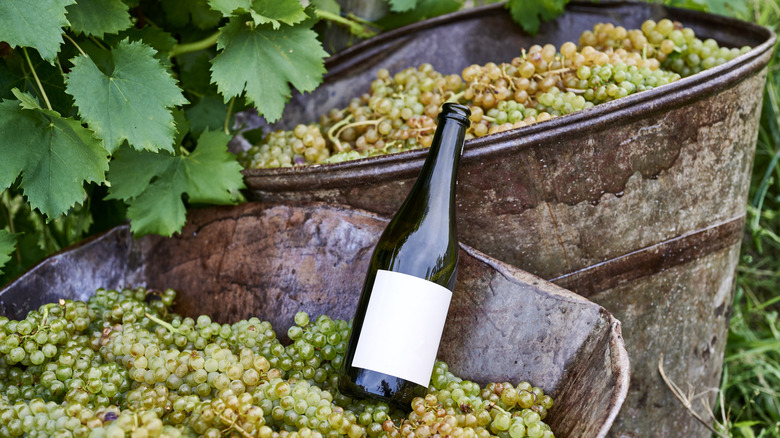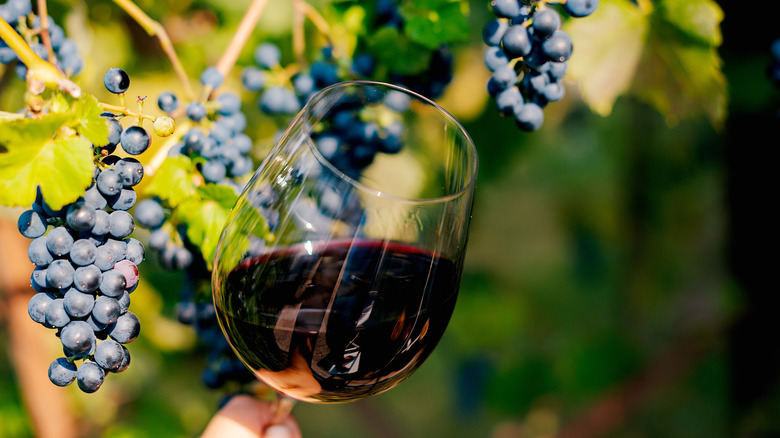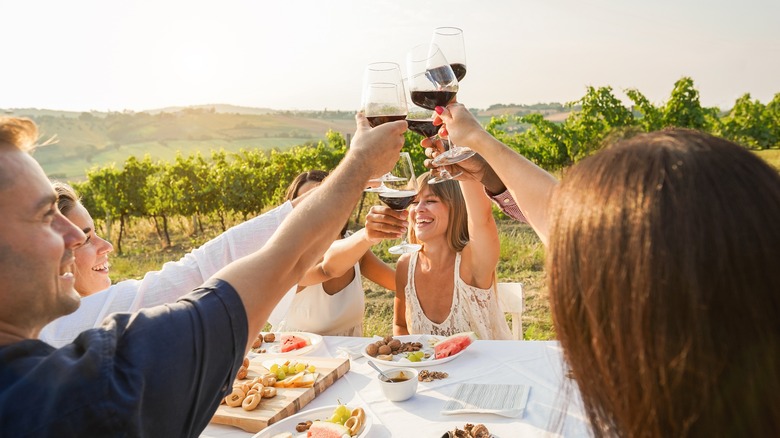Here's What It Means When Tourists See 'Natural Wine' On A Menu In France
If you're dining out on vacation in France, you may have seen some wines listed on the menu as "natural." The creation of natural wine is popular in areas like the lovely corner of France called Languedoc, the Loire Valley, and Jura, but these days you may even see them in your local wine shop. You might not have heard of natural wines, but if you're an oenophile (which means "wine lover"), this may help you decide on that perfect glass on vacation. A natural wine is made with organic grapes grown with no pesticides or herbicides, but that's not all. You can get organic wines that aren't natural. A true natural wine uses naturally occurring yeasts or organic yeasts for fermentation, and has no additives at all.
The sulfates in natural wine are low or nonexistent, and it is unfiltered. It's said that this wine may not give you a hangover, though that all depends on how much you drink. (We're not recommending you test that theory. It's still alcohol.) There are other things that make natural wine stand out from the rest of the listing on that French menu, and it might just become your favorite libation. Make sure to add "Avez-vous du vin naturel?" ("Do you have natural wine?") to the French phrases you must learn before your trip to France.
All about making natural wine
Natural wine started to rise in popularity in the 1990s in Paris, and even celebrities like Dua Lipa and Action Bronson have posted about it on their platforms. What's funny about it is that this was really the way wine was made before it was mass produced. Many usual wines have additives, like things to clarify the liquid, including egg whites and dried fish bladders, or a food dye called Mega Purple that darkens red wines. Natural wines don't have any additives.
Another difference you may notice as you drink it (which may have something to do with the belief that it doesn't cause hangovers — again, we don't recommend drinking enough to give yourself one, even with these), is that it has a lower alcohol content than most wines. Generally natural wines have between a 10 and 12% ABV or alcohol by volume. The average ABV for regular wine is between 15.5 and 25%. If you're trying several wines from the menu in France because you want to get a wide sampling, that's at least a bit less alcohol. You want to remember what you drank, after all.
Natural wines aren't filtered, as we mentioned. That gives them a sort of cloudy appearance. You may find sediment in the bottle, which is fine to drink if you don't mind it. If you're not heading to Europe any time soon and you want to try some natural wine, you may very well find some bottles near you, and not just ones from France. Italy, Spain, and Australia are also home to several vineyards that use this method.
Natural wines to try in France and at home
There are a few natural wines you may want to try out to see if you like the style and flavor. They may have a slightly different taste from what you're used to and can vary a bit, even from the same group of bottles. You'll just have to experiment. That said, Eric Asimov, the chief wine critic for The New York Times, recommends Matassa Vin de France Tattouine Rouge 2020. (Who knew something good would come out of that year?) It is a pale red made from Grenache gris and Carignan varietals. It has a high tannin taste but 10% ABV.
Two natural wines recommended by Taste France are Domaine Matin Calme Mano a Mano, a light red with an earthy taste, as well as Domaine Sylvain Pataille Les Mechalots, which is a white made with a Chardonnay varietal. You can get natural wines of every style, from red to white, orange to rosé, dry to sweet, and even sparkling. It's the method, not the grape that creates natural wine. Some online stores like Primal Wine have an entire section dedicated to natural wines of all types, and even restaurants like Los Angeles' Anajak Thai (whose chef won a James Beard Award and won Food & Wine's Best New Chef Award in 2022) serve natural wine. À votre santé!


